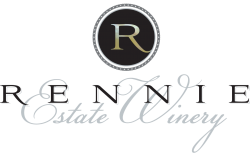NIAGARA’S RENNIE ESTATE WINERY, COMES OUT OF THE GATE WITH A STRONG, INTERESTING PORTFOLIO OF WINES
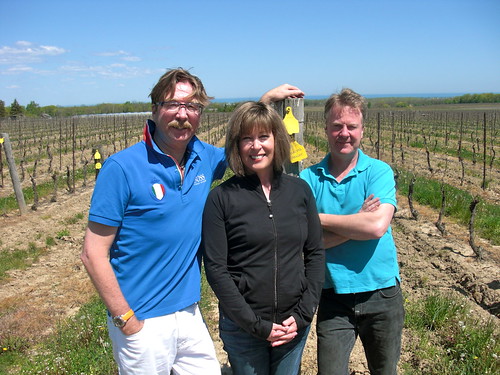
It’s a bucolic setting with stunning views looking down and across Lake Ontario to the Toronto skyline on a brilliant, clear day in May.
Standing on the pool deck at Christine and Graham Rennie’s (seen in top photo with winemaker Philip Dowell) gorgeous guest house, perfectly perched on the Beamsville Bench, you can almost touch the vines that are planted at the Heron Pond Benchland Vineyard as they soak up the sun and sway gently in the warm spring breeze.
 Rennie Graham photo of the view from the Rennie vineyard.
Rennie Graham photo of the view from the Rennie vineyard.The Rennies are the latest to take the plunge in Niagara wine making with their Rennie Estate Winery. But they have not rushed into their project. The couple has taken a thoughtful and reasoned approach to bottling a portion of their premium grapes under their own label and culled from 44 acres of planted fruit.
First the Rennies, who are from Oakville where Graham is the founder of Integra Capital Management, purchased the 50-acre site in 1997 after scouring the area for the perfect place to plant grapes.
 A view of the Rennie house, vineyards and guest house (photo by Graham Rennie)
A view of the Rennie house, vineyards and guest house (photo by Graham Rennie)You see, like many who come to Niagara, the Rennies had a dream. It was a dream that began in the early 1980s. The newly married couple had travelled to many of the great wine regions in the world, including Napa Valley, Oregon and France.
A passion for wine followed and a yearning to become winegrowers in Niagara was vigorously pursued.
When they came across the Walters farm, one of the oldest vineyards in Niagara, but hadn’t produced grapes since the 1960s, it wasn’t much to look at after decades of neglect. “But when Christine looked across the lake and said: ‘Yes, this is the place,’ ” said Graham, that was it. They bought the farm.
With advice from many high-profile wine industry leaders, including Donald Ziraldo (co-founder of Inniskillin), Donald Triggs (co-founder of Jackson-Triggs), Martin Malivoire (owner of Malivoire) and Len Pennachetti (Cave Spring), to name a few, the couple set about plotting their vineyard.
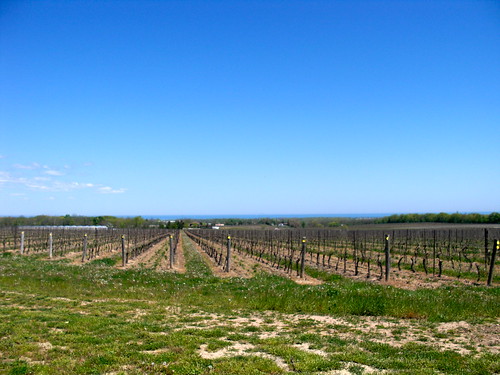
The Rennies sourced Chardonnay (Dijon clone 76), Pinot Noir (Dijon clone 113) Cabernet Sauvignon (clone 169), Cabernet Franc (clone 210) and Merlot (clone 184) from the Mercier nursery in France. The vineyard was planted in the spring of 1999 with spacing at 1,275 vines per acre with eight-feet-wide rows. The varietal mix is 28% Pinot Noir, 17% Chardonnay, 20% Merlot, 20% Cabernet Franc and 15% Cabernet Sauvignon.
The fruit produced on the farm is at the high end of quality and has found a home in Jackson-Triggs’ and Inniskillin’s top bottlings.
The Beamsville Bench where the Rennies have built their vineyard and home is situated on a naturally sloping benchland bordered on the south by the Niagara escarpment and to the north by Lake Ontario
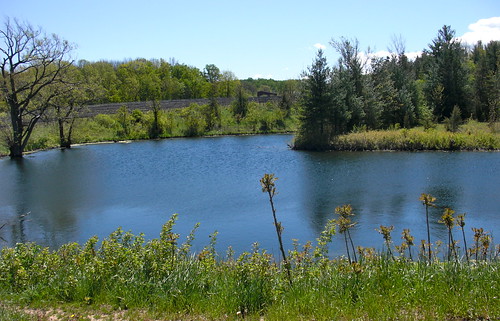 Heron Pond.
Heron Pond.The slope of the Bench and the constant airflow from Lake Ontario provides a unique micro climate which cools vineyards during the hottest summer months and facilitates the removal of cold air during the winter months. The character of the wines made there is influenced by the considerable limestone deposits found within the calciferous clay and loam rich soils, which are carved out of the escarpment and forests that surround the vineyards.
The couple has built a stunning home and guest house on the property and have since moved in with their family and have slowly become part of the Niagara lifestyle. They say their network of other vineyard and winery owners, including Norm Beal (Peninsula Ridge), Harald Thiel (Hidden Bench) and Nicolette Novak (Good Earth Wine Company), “has been very supportive and helpful” as they transitioned from growers to producers.
It just wasn’t enough, said Graham, to grow the grapes. Every vintage he would buy a barrel of his own juice and bottle it for his own consumption.
“So, I thought I would step up from lowly grower,” he says, laughing, “to making my own wine.”
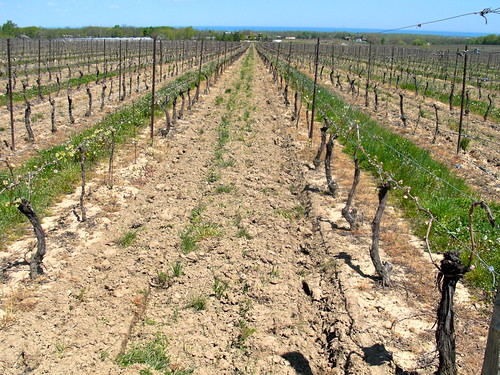
His main concern was standing out in an already crowded market. “I want to make wine, but does Ontario need another Pinot Noir or Chardonnay,” he said.
A tough question to ask, since the Rennie Vineyard grows some pretty exciting Chardonnay and Pinot Noir right out of the gate and both those varieties figure strongly in his portfolio. But he wanted something else, something unique and something that would showcase his Bordeaux varietals.
The solution to Rennie’s own question was found 6,800 kilometres away in Verona, Italy, where he was smitten by the appassimento style of wines being made in Valpolicella.
Grapes there are dried after harvesting for up to 120 days to add complexity and structure to the wines.
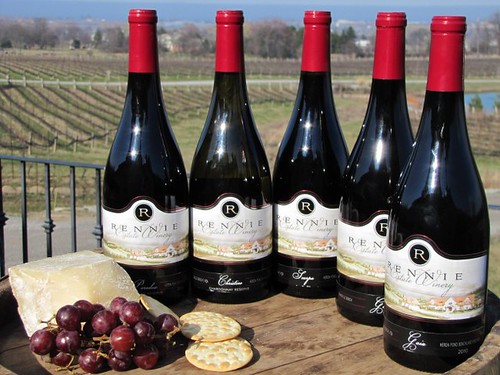 The Rennie portfolio (Graham Rennie photo)
The Rennie portfolio (Graham Rennie photo)“The process makes so much sense to me,” said Graham, especially in Niagara where the big red varieties are susceptible to vintage variation. So he set about experimenting with his own Cabernet Franc. In 2009 he harvested a tonne of it and used a greenhouse to the dry the grapes. The grapes were harvested at 22.5 brix and dried to 29 brix before pressing.
It was modelled after a traditionally-made Amarone wine, finished at 17% alcohol. Graham knew he was on to something but wanted to perfect the drying method he was using to gain more control over temperature, humidity and the speed at which the grapes dried. The slower the process, the better the concentration of the grapes.
He approached Vineland Research Station and helped fund a project to re-create the perfect conditions for drying grapes in a specially designed room. The 2011 vintage of his appassimento style wines are the first to be made in the new special room at Vineland Research Station.
The Rennies do not have a winemaking facility on their property so they have partnered with Angels Gate to make the wines there.
Angels Gate winemaker Philip Dowell has signed on as the winemaker for the hybrid virtual winery. Graham said Dowell’s “passion for Pinot Noir and Chardonnay, as well as his significant experience in producing rich, full bodied Australian wines” is a perfect combination for crafting both the “super Niagara” wines (dried grapes) and “terroir-driven” wines (Chardonnay and Pinot Noir) made at the new winery.
Rennie’s “super Niagara” wines include the Gaia, an appassimento style wine made from Heron Pond Benchland Vineyard Merlot. The grapes were dried for 57 days in the new custom drying room at the Vineland Research Centre and then aged for 18 months in new French oak. The other wine in the series is the Scarpa made from Cabernet Sauvignon and Cabernet Franc from estate grapes and made in a ripasso style (the juice from the Cabernets combined in tank with the skins from the Gaia) and aged for 14 months in new oak.
The two “terroir-driven” wines are the Paradox Pinot Noir Reserve and Christine Chardonnay Reserve, both made with estate fruit. Rennie wines are made in very small quantities (under 200 cases each) and can be found at the retail store at Angels Gate or through the Rennie Wine Club.
Here’s what’s available from the first commercial vintage:
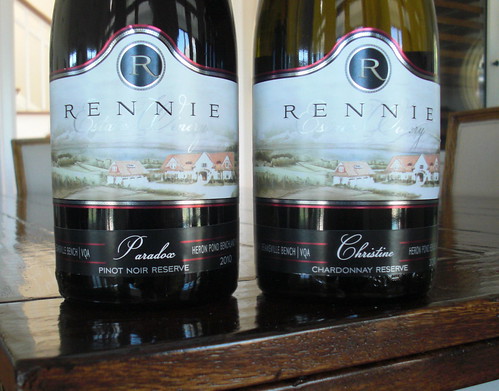
Rennie Estate Winery Christine Chardonnay Reserve 2010 ($35, 89 points) — What a beautiful first effort from Rennie, with an expressive nose of ripe pear, summer peach, intriguing minerals, fig and elegant vanilla-oak nuances. It’s soft and fleshy on the palate with rich, opulent fruit flavours, integrated spice and a creamy texture through the finish.
Rennie Estate Winery Paradox Pinot Noir Reserve 2010 ($40, 90 points) — Rennie’s Pinot is classic Beamsville Bench with a nose that shows beetroot, black cherry, cranberries, earth and lavish spice accents. It is a young wine, still evolving, with the toasted cran-cherry and vanilla notes coming together with the core of spice and minerals. Tuck this away for two or three years.
Rennie Estate Winery Scarpa 2010 ($50, barrel sample, not rated) — The Rippaso style Scarpa I tried was a barrel sample and unfair to rate it until it’s been bottled. The nose shows very ripe cassis, currants and raisin-plum notes. It is very concentrated and ripe on the palate with sweet dark fruits, kirsch and an array of spices through the finish.
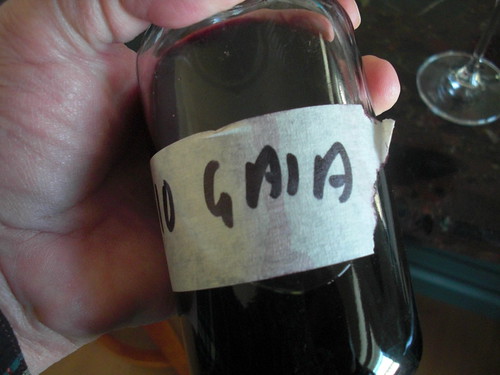 The barrel sample of the Gaia.
The barrel sample of the Gaia.Rennie Estate Winery Gaia 2010 ($75, barrel sample, not rated) — This is pretty exciting stuff, an extravagant wine made in the appassimento style that is gaining favour in Niagara. What was started by Foreign Affair, has now grown to include Colaneri, Organized Crime, Cave Spring, Reif Estates and others who are trying this method of drying grapes in one fashion or another. Rennie enlisted the help of the Vineland Research Centre to perfect a method of drying that slowly concentrates the grapes under perfect conditions. The result is this extraordinary wine that has a meaty, hedonistic nose with layers of highly extracted black fruits, spice and Espresso notes that are revealed in layer after layer. It is big, literally big, at 17% alcohol, but is backed up by a wall of fruit, tannins and acidity to bring it somewhat into balance. I can’t wait to see this wine finally bottled.
Rennie Estate Winery Gaia 2009 (not commercially available, 93 points) — Why even write about a wine that the Rennies only bottled for personal consumption? Because it’s awesome, that’s why. I enjoyed a bottle over a few days and could not believe how this wine evolved and delivered so much pleasure over three days. This was made from grapes dried for 65 days (in a greenhouse). It is intense on the nose with dark, thick fruits, licorice, bramble bush, cherry-kirsch, bacon fat, mocha and firm oak notes that swirl and evolve in the glass. It is big, bold, rich and layered with sweet and smoky spice, smoky spice, lanise, wild savoury herbs and length through the finish. This is a wine you want to experience from Niagara.
